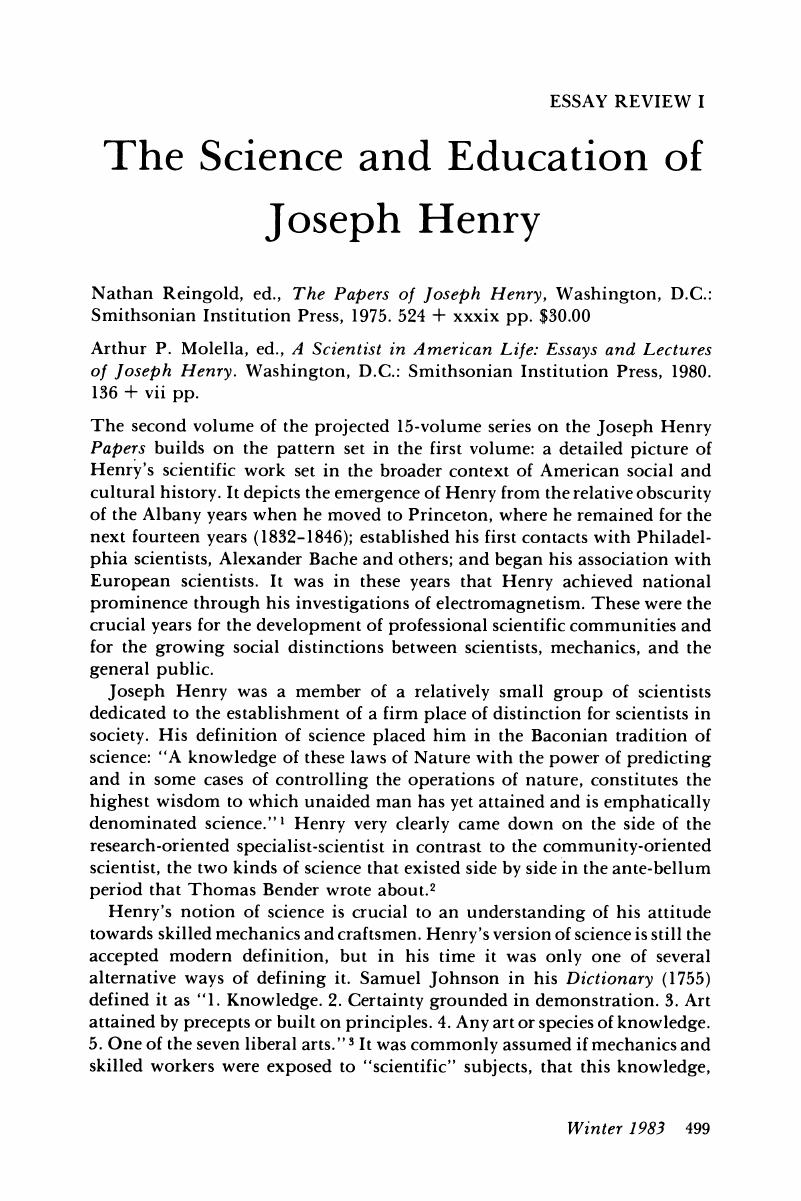No CrossRef data available.
Published online by Cambridge University Press: 24 February 2017

1. Molella, Arthur P. (ed.), A Scientist in American Life: Essays and Lectures of Joseph Henry, (Washington, D.C., 1980), p. 47.Google Scholar
2. Bender, Thomas, “Science and the Culture of American Communities: The Nineteenth Century,” History of Education Quarterly 16 (1976): 63–77.Google Scholar
3. Quoted in Thackray, Arnold, (ed.), Science and Values (New York, 1974), p. 3.Google Scholar
4. Reingold, Nathan (ed.), The Papers of Joseph Henry, Vol. 2, pp. xxii–xxiv, 28–29.Google Scholar
5. An indispensable starting point on this subject is Rupert Hall, A., “The Scholar and the Craftsman in the Scientific Revolution,” in Clagett, Marshall (ed.), Critical Problems in the History of Science (Madison, 1959). See also Burns, Rex, “The Social Character of Technology,” Impact, 7 (1956): 150–51, 155.Google Scholar
6. Philosophy, Technology and the Arts in the Early Modern Era, trans. Attanasio, Salvator and edited by Nelson, Benjamin (New York, 1970), p. 112.Google Scholar
7. Molella, (ed.), Essays and Lectures, p. 66. Henry's essay, “Closing Address before the Metropolitan Mechanics' Institute,” pp. 54–70, is a full exposition of his approach to this subject.Google Scholar
8. Ibid., p. 63.Google Scholar
9. Ravetz, Jerome R., Scientific Knowledge and Its Social Problems (Oxford, 1971), 75–76, 109, 117–118, 144.Google Scholar
10. Paolo Rossi, in Philosophy, Technology and the Arts, pp. 61–62. For a perceptive theoretical statement on this subject, see Polanyi, Michael, Personal Knowledge (New York, 1958), pp. 86–87.Google Scholar
11. Aronowitz, Stanley, False Promises: The Shaping of American Working Class Consciousness (New York, 1973), pp. 155–56. For a more complete analysis of this point see Sohn-Rethel, Alfred, Intellectuals and Manual Labour: A Critique of Epistemology (Atlantic Highlands, New Jersey, 1978).Google Scholar
12. Wallace, Anthony F. C., Rockdale: the Growth of an American Village in the Early Industrial Revolution (New York, 1978), p. 150.Google Scholar
13. Ibid., pp. 212–15.Google Scholar
14. Molella, (ed.), Essays and Lectures, pp. 17–22.Google Scholar
15. The classic model was the Paris Academy of Sciences. See Hahn, Roger, The Anatomy of a Scientific Institution: The Paris Academy of Sciences, 1666–1803 (Berkeley and Los Angeles, 1971). See also, Tilly, Louise A., “From Provincial Culture to the Paris Academy,” History of Education Quarterly, 14 (Winter 1974): 519–23.CrossRefGoogle Scholar
16. Miller, Lillian B., The Lazzaroni: Science and Scientists in Mid-Nineteenth-Century America (Washington, D.C., 1972); Beach, Mark, “Was There a Scientific Lazzaroni?” in Daniels, George (ed.), Nineteenth-Century American Science: A Reappraisal (Evanston, Illinois, 1972), pp. 115–32.Google Scholar
17. Reingold, , The Papers of Joseph Henry, vol. 2, pp. 290–91, n. 13.Google Scholar
18. Ibid., pp. 110–111.Google Scholar
19. Molella, (ed.), Essays and Lectures, pp. 126–27. For a fine exposition on these tensions see Ezrahi, Yaron, “The Authority of Science in Politics,” in Thackray, Arnold (ed.), Science and Values (New York, 1974), pp. 224–25. For professionalization in science see Reingold, Nathan, “Definitions and Speculations: The Professionalization of Science in America in the Nineteenth Century,” in Oleson, Alexandra (ed.), The Pursuit of Knowledge in the Early American Republic (Baltimore and London, 1976), pp. 33–69; Kohlstadt, Sally Gregory, The Formation of the American Scientific Community (Urbana, Illinois, 1976).Google Scholar
20. Molella, (ed.), Essays and Lectures, p. 38.Google Scholar
21. The Mechanics' Free Press, (Philadelphia), (July 18, 1829).Google Scholar
22. It is often forgotten that the Friends of Education, the supporters of the common school movement, were composed not only of prominent Whigs and Federalists, business and professional people, but also of artisans who had quite different views about how their children should be educated. See Montgomery, David, “The Shuttle and the Cross: Weavers and Artisans in the Kensington Riots of 1844,” Journal of Social History 5 (1972): 423–24. Along the same lines see Boston Mechanic and Journal of the Useful Arts, quoting The Journal of Health on the importance of health education for workers. They work in “damp and unhealthy mines, in wells and cellars subject to poisonous fumes, lack of exercise, use of certain tools, and instruments. Should workers depend on professionals to guide them? No. If they [the workers] know the principles they will respond better and, secondly, they know their peculiar circumstances and can apply rules accordingly better than the general approaches of the professional.” 4 (April 1835): 11–12.Google Scholar
23. Quoted in The Workingman's Advocate, New York (April 17, 1830).Google Scholar
24. From Ferguson, Eugene S. (ed.), Early Engineering Reminiscences (1815–40) of George Escol Sellers (Washington, D.C., 1965), p. 38, quoted in Wallace, , Rockdale, pp. 227–28. See also Rosenberg, Nathan, Technology and American Economic Growth (New York, 1972), pp. 54–55.Google Scholar
25. Wallace, , Rockdale, pp. 232–33.Google Scholar